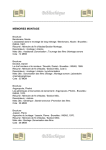Download Nikon Nuvis A20
Transcript
V ? Nikon Nuvis A20 Instruction Manual Manual de instrucciones ACVANCEH) / \ P H O T O SYSTEM; SJH Fig. A Fig. B Fig.C Contents English Espanol Figs Nikon Service Warranty 1-15 17-32 33-40 42-46 English Foreword Thank you for purchasing the Nikon Nuvis A20/Nuvis A20 QD camera, a compact, funto-use camera. However, in order to obtain the best results, be sure to read this instruction manual thoroughly before you begin. The Nikon Nuvis A20/Nuvis A20 QD camera employs the Advanced Photo System (1X240 System) featuring: • Extremely simple "drop-in" film loading • 3 different print types on the same roll of film • Prevention of accidental double exposures Camera parts Fig. A ©Self-timer button © Shutter release button ® Mid-roll rewind button © Self-timer indicator/ red-eye reduction lamp © Strap eyelet © Power switch/lens cover ©CHP selector ©Viewfinder window © Flash ® Auto exposure metering window © Autofocus windows ©Anytime flash/red-eye reduction button ©Lens Fig. B ® Viewfinder eyepiece © LCD panel © Cartridge chamber cover ©Cartridge chamber lock release ©Tripod socket © Battery chamber cover @ Frame counter © Flash ready-light indicator @ Cartridge indicator Precautions • Please make sure you are fully conversant with the operations and features of your new camera by reading these instructions before using it for special occasions (holidays, wedding, etc.) • Do not leave your camera in an excessively hot place; store it in a cool, dry place. Battery power weakens in extremely low temperatures. • When not in use, be sure to close the camera's lens cover to turn the power OFF and keep the camera in a safe place. • In the event of camera failure, do not attempt to disassemble or repair the camera yourself. First, replace the batteries. If that dqes not work, take the camera to your nearest authorized Nikon service center. Attaching the strap (See Fig. C.) Thread the wrist strap through the eyelet, then pass the other end through the loop and pull it tight. —2— Installing batteries (See Fig. D on page 33.) 1 To open, pull up the battery chamber cover in the direction of the arrow. 2 Install two AA-size alkaline batteries, with the + and - poles oriented as shown inside the battery chamber. 3 Push the battery chamber cover back into place until it clicks shut. Notes • Do not use NiCd batteries. • Remove batteries from the camera when not in use for a long time. • Do not break open or try to recharge batteries. • Do not throw batteries into the fire. • Keep batteries out of the reach of children. • Be sure to replace the batteries with a fresh set if you notice any delays in recharging flash. Film speed setting Correct film speed is automatically set when ISO 100 or ISO 200 film is loaded. With any film faster than ISO 200, film speed is automatically set to ISO 200 regardless of the actutal ISO rating. Loading the film (See Figs. E-H on pages 34-35.) Use only a fresh 1X240 film cartridge. Conventional 35mm film cannot be used. There is no film leader! Film is automatically thrust and loaded inside the camera. Fig.E 1X240 film cartridge Visual Exposure Indication (VEI) © D: Processed film inside the cartridge (DO: Unexposed film © D : Partially exposed film ® Irreversible Processed Indicator (IPI) ©S3: Fully exposed but unprocessed film ©Lightlock Door ©Lightlock Door Drive ©Cartridge Spool ©Data Disk 1 Open the lens cover to turn the camera ON and make sure no Q - appears in the LCD panel. Slide the cartridge chamber lock release to open the cover. (Figs. F, H) Note: Do not try to open the cartridge chamber cover while film is loaded. —4— 2 Insert a fresh film cartridge in the cartridge chamber as shown. Q_ appears in the LCD panel when the cartridge is inserted in the chamber. Close the cartridge chamber cover until it clicks shut. (Fig. G) Note: Check that the VEI shows O before loading. A film cartridge displaying D, • or Z$ cannot be inserted. 3 Press the shutter release button and the film automatically advances until the number " 1 " appears in the frame counter. Notes about 1X240 film cartridge • Do not disassemble or subject to shock or vibration. • Be careful not to soil or damage the cartridge contacts, as correct data communication may be impaired. • Do not press on the Lightlock Door Drive with a pointed object (e.g. a pen), as this may open the door and expose the film. • Do not break the Irreversible Processed Indicator (IPI) on the cartridge, as film processing and printing may become impossible. Consult your photo lab if IPI is broken. —5— • Do not attempt to rotate the Cartridge Spool with a pointed object (e.g. a screwdriver). This can expose the film, alter the VEI, or prevent proper use and/or processing. • Do not store the film cartridge: —In direct sunlight, near heating appliances or in a hot place —Around dirt or dust —In hot or humid moldy environments —Near strong magnetic devices (jirkifiecL P r o c e s s i n g a n d printing We recommend bringing your film cartridge to a photo lab displaying the "Authorized Photo Lab Mark" sign for processing and printing. f~Jnoiiofiri£iSni*ia Authorized Photo Lab Mark —6— Authorized Photo Labs offer the following services • 3 different print types (C, H or P-type). • Index Prints (small images of each frame exposed on the roll of film) • Negative Return in Cartridge (NRIC) Your negatives are returned inside the cartridge for easy storage. For further details, ask your authorized photo lab. Selecting a print type (See Figs. l-J on page 35.) Print type (C, H or P-type) can be changed at any time while film is loaded. C-type: Vertical vs. horizontal = 2 : 3 (aspect ratio) H-type: Vertical vs. horizontal = 9 : 1 6 (aspect ratio) P-type: Vertical vs. horizontal = 1:3 (aspect ratio) Viewfinder indications (See Fig. K on page 36.) © C/H/P-type image size fra*me marks © Autofocus frame mark. Center this mark on the subject. Taking pictures (See Fig. L on page 37.) 1 Open the lens cover to turn the camera OM. Indicators appear in the LCD panel. 2 Hold the camera steady with both hands. Be careful not to block the flash, autofocus windows or lens with your fingers. 3 To ensure sharp pictures, make sure your subject is at least 0.9m (3.0 ft) away from the camera.* 4 Look through the viewfinder and position the autofocus frame marks on the main subject. 5 Lightly press the shutter release button to focus the subject. —8— 6 Fully depress the shutter release button to take the picture keeping the autofocus frame mark on the main subject. • Pictures can be taken only when the lens cover is open all the way. *Note: If the camera-to-subject distance is closer than 0.9m (3.0 ft), an out-of-focus picture may result. Self-timer operation (See Fig. M on page 38.) 1 Turn the camera ON and press the self-timer button. 2 The self-timer indicator blinks for 8 sec, then lights up for 2 sec. before the shutter is released. To cancel self-timer operation, close the lens cover or press the self-timer button again. Flash photography Auto flash mode (default) The camera determines when flash is needed and fires the flash automatically. Recommended flash shooting range is as follows: —9— Flash shooting distance range Film speed ISO 100 ISO 200 ISO 400 Flash shooting range Approx. 0.9 to 2.8m (3.0 to 9.2 ft.) Approx. 0.9 to 3.9m (3.0 to 12.8 ft.) Approx. 0.9 to 5.5m (3.0 to 18.0 ft.) To take a picture with flash 1 Lightly press the shutter release button to focus the subject. Note: As soon as the flash is fully charged, H lights up in the LCD panel. It blinks while the flash is charging. The LCD panel automatically goes out when the camera is not in use for approx. 120 seconds; it lights up again when you press the shutter release button lightly. 2 Fully depress the shutter release button to release the shutter. Recharging takes approx. 7 seconds. — 10— "Anytime flash" mode (See Fig. N on page 38.) Whenever you want to use fill-flash for backlit situations, press the "anytime flash/red-eye reduction" button while shooting. Red-eye reduction In flash photography, the subject's eyes sometimes appear bright red in color pictures due to a phenomenon known as "red-eye." To counteract this effect, your camera is equipped with a red-eye reduction lamp. Under low light situations, when releasing the shutter with the "anytime flash/red-eye reduction" button depressed, the red-eye reduction lamp automatically lights up, causing the size of the subject's pupil to grow smaller, minimizing the red-eye effect. H o w t o u s e f o c u s lock (See Fig. O on page 38.) 1 Center the autofocus frame mark on the subject. 2 Lightly press the shutter release button to lock focus on the subject. 3 Keeping the shutter release button lightly pressed, recompose the scene. Then fully depress the shutter release button. Note: To cancel focus lock, simply remove your finger from the shutter release button. Special focusing situations (See Fig. P on page 39.) The following subjects may be too difficult to focus: a. Subjects too small to fully cover the autofocus frame mark b. Subjects behind glass c. Dark subjects with no reflection d. Glossy, light-reflecting surfaces, such as shiny cars or water e. Subjects without solid content (i.e. candle flame, fireworks, etc.) In the above cases, use focus lock. Rewinding the film (See Figs. Q-R on page 40.) 1 At the end of the roll, the film starts rewinding automatically. The frame counter counts backwards until the film is rewound completely. 2 Open the cartridge chamber cover and remove the film after checking that the number "0" is blinking in the LCD panel. •You can rewind the film midway through the roll. Press the mid-roll rewind button. (Fig. R) — 12— Specifications Type of camera Usable film Information exchange system Print aspect ratio Lens Shutter Focusing Shooting distance Viewfinder Viewfinder information Exposure control Film speed setting 1X240 (Advanced Photo System) type autofocus lens-shutter camera 1X240 System (Advanced Photo System) film cartridge (16.7 x 30.2mm) Optical Information Exchange (Opt. IX) system C, H and P-type available 25mm f/5.6 (31mm converted to 35mm type); 3 elements in 3 groups Programmed electronic shutter; also serves as diaphragm blades; Shutter speed: 1/125 or 1/200 sec. (daylight), 1/50 sec. (flash) Infrared-active autofocus system with focus lock; Activated by lightly pressing shutter release button 0.9m (3.0 ft.) to infinity Reverse Galilean Albada-bright frame type; Approx. 0.4x magnification C/H/P-type image size frame marks; Autofocus frame Electronically controlled program AE ISO 100 and ISO 200 film automatically set; With films faster than ISO 200, film automatically set to ISO 200. — 13— Film operation Drop-in loading system; Double Exposure Prevention (DEP) available; Film automatically advances to the first frame when shutter is released after inserting cartridge; Film automatically advances by one frame after each shot; Auto rewind at the end of film roll; Mid-roll rewind function available Frame counter Shown in the LCD panel; additive type Self-timer Electronically controlled; Activated by depressing self-timer button; 8 sec. blinking and 2 sec. lighting up; One shot operation Flash Built-in auto flash and Anytime flash; Recycling time of approx. 7 sec; Guide number 13 (ISO 200 in meter) Flash shooting range Approx. 0.9-2.8m (3.0-9.2 ft.) at ISO 100, 0.9-3.9m (3.0-12.8 ft.) at ISO 200, 0.9-5.5m (3.0-18.0 ft.) at ISO 400 Red-eye reduction mode Red-eye reduction lamp lights up for approx. 0.7 sec. before flash fires Battery life Approx. 15 rolls of 25-exposure film with flash for half of all exposures Power source Two AA-type alkaline batteries — 14— Auto power off With the power ON, camera power automatically turns OFF after approx. 120 sec. when the camera is not in use. To turn the power ON again, lightly press the shutter release button. Dimensions (WxHxD) Approx. 113 x 62 x 36mm (4.4 x 2.4 x 1.4 in.) (Nuvis A20) Approx. 113 x 62 x 39mm (4.4 x 2.4 x 1.5 in.) (Nuvis A20 QD) Weight (without batteries) Approx. 150g (5.3 oz.) (Nuvis A20) Approx. 155g (5.5 oz.) (Nuvis A20 QD) Specifications apply when fresh batteries are used at normal temperature (20 °C or 68 'F). Specifications and design are subject to change without notice. — 15— NOTE: On battery life Any delays in flash recycling times, indicate the need to replace the batteries. If the flash ready-light indicator V does not come on, shooting is no longer possible. As the temperature drops, battery power decreases. In low temperatures, use fresh batteries. If necessary take the batteries out and keep them warm in a coat pocket or other warm place. — 16— Espanol Prefacio Muchas gracias por su compra de la camara Nikon Nuvis A20/Nuvis A20 QD, compacta y divertida de usar. Sin embargo, para que pueda disfrutar al maximo de esta camara lea todas las instrucciones de este manual antes de empezar a usar la camara. La camara Nikon Nuvis A20/Nuvis A20 QD utiliza el Sistema fotografico de adelantada (Sistema 1X240) que tiene las siguientes caracteristicas: • Carga de pelicula sencilla colocada automaticamente • 3 diferentes proporciones de imagen en un mismo rollo de pelicula • Mecanismo para evitar una doble exposicion accidental Piezas de la camara Fig. A © Boton del autodisparador © Boton del obturador © Boton de rebobinado en el medio del rollo © Indicador del autodisparador/lampara de reduction de ojos rojos © Argolla para la correa © Interrupter principal/tapa del objetivo ® Selector de proporciones CHP Ventanilla del visor © Flash Ventanilla del medidor para la exposicion automata Ventanillas para el enfoque automata Boton de flash en cada fotografia/ reduction de ojos rojos Objetivo — 17— Fig.B @ Ocular del visor 15 Pantalla de cristal liquido 16 Cubierta de la camara del cartucho © Liberation del seguro de la camara del cartucho ® Rosea para tripode ® Cubierta del compartimiento de las pilas ® Contador de fotogramas © Indicador de flash listo 22 Indicador de cartucho Precauciones • Asegurese de que entiende perfectamente el f uncionamiento y las caracteristicas de su nueva camara leyendo estas instrucciones antes de utilizarla para una ocasion especial (para sus vacaciones, para un casamiento, etc.) • No deje su camara en un lugar muy caliente, guardela siempre en un lugar seco y a la sombra. La corriente de las pitas se debilita a temperaturas muy bajas. • Cuando no se esta utilizando, cierre la tapa del objetivo de la camara para desconectar la camara y guarde la camara en un lugar seguro. • En el caso de que la camara no funcione, no trate de desarmarla o reparar la camara por su cuenta. Pruebe a cambiar primero las pilas. Si no se soluciona el problema, lleve la camara al centra de servicio autorizado de Nikon mas cercano. Colocacion de la correa (Vea la figura C.) Pase la munequera por la argolla y pase la otra punta por el bucle, apretando firmemente el nudo. — 18— Instalacion d e las pilas (Vea la figura 0 en la pagina 33.) 1 Abra la tapa del compartimiento de las pilas en el sentido de la flecha. 2 Instale primero la pila "A" y despues la pila "B" con los polos + y - orientados tal como en la figura D. Saque las pilas en el orden inverso. (Utilice dos pilas alcalinas de tipo AA.) 3 Vuelva a cerrar la tapa del compartimiento de las pilas hasta que se asegure en su lugar. Notas • No utilice pilas de niquel-cadmio. • Saque las pilas de la camara si no se la va a utilizar durante mucho tiempo. • No trate de desarmar o recargar las pilas. • No tire las pilas al fuego. • Guarde las pilas en un lugar fuera del alcance de los ninos. • Sustituir las pilas por unas nuevas en cuanto se aprecie que se retrasa el reciclado. Ajuste de la sensibilidad de la pelicula La sensibilidad de la pelicula se ajusta automaticamente al valor correcto cuando se coloca pelicula de IS0100 o ISO 200. Si se coloca una pelicula con una sensibilidad de mas de ISO 200, se ajusta automaticamente a ISO 200 sea cual sea la sensibilidad ISO real. —19— Carga de la pelicula (Vea las figuras E-H en la pagina 34-35.) Utilice solo cartuchos de pelicula 1X240 nuevos. No puede utilizar las peli'culas comunes de 35 mm. No hay gufa de pelicula. La pelicula entra y se carga automaticamente dentro de la camara. Fig. E Cartucho de pelicula 1X240 Indication de exposition visible (VEI) © D: Pelicula procesada dentro del cartucho ©Puerta hermetica ©Mando de puerta hermetica © O : Pelicula sin exponer ©Carrete de cartucho © D : Pelicula parcialmente expuesta © Indicadorde procesamiento irreversible (IPI) ©Disco de datos © tZ: Pelicula totalmente expuesta pero sin procesar 1 Abra la tapa del objetivo para conectar la camara y confirme que no aparece tten la pantalla de cristal liquido. Deslice el seguro del compartimiento del cartucho para abrir la tapa. (Fig. F y H) Nota: No trate de abrir la tapa del compartimiento del cartucho cuando la pelicula esta cargada. —20— 2 Coloque un cartucho de pelicula nuevo en el compartimiento del cartucho como en la figura. Aparece Q - en la pantalla de cristal liquido cuando coloque el cartucho en el compartimiento. Cierre la tapa del compartimiento del cartucho hasta que se produzca un chasquido. (Fig. G) Nota: Compruebe que el VEI indica o antes de cargar. No puede colocar un cartucho de pelicula con las indicaciones D, D oti. 3 Oprima el boton del obturador para que la pelicula avance automaticamente hasta que aparezca el numero " 1 " en el contador de fotogramas. Notas sobre el cartucho de pelicula 1X240 • No desarme o exponga a golpes o vibraciones. • No ensucie o dane los contactos del cartucho porque puede verse afectada la comunicacion de datos. • No haga presion sobre el mando de la puerta hermetica con un objeto puntiagudo (por ejemplo un bolfgrafo), porque puede abrirse la puerta y la pelicula quedara velada. —21 — • No rompa el indicador de procesamiento irreversible (IPI) en el cartucho porque se volvera imposible de procesar e imprimir las fotografias. Consulte con el laboratorio fotografico mas cercano si el IPI esta roto. • No trate de girar el carrete del cartucho con un objeto puntiagudo (por ejemplo un destornillador). Esto puede exponer la pelicula, modificar el VEI o provocar una utilization o procesamiento incorrectos. • No guarde el cartucho de pelicula en un lugar: —Expuesto a los rayos del sol, calefaccion o lugar caliente. —Sucio o con polvo Servicio —Humedo con moho Fotografico —Cerca de aparatos que generen campos magneticos fuertes Procesamiento e impresion Recomendamos llevar el cartucho de pelicula a un laboratorio fotografico con la "Marca de laboratorio fotografico autorizado" para su procesamiento e impresion. —22— Servicio de Fotoacabado Certificado Certificado Marca de laboratorio fotografico autorizado Los laboratories fotograficos autorizados ofrecen los siguientes servicios • 3 diferentes relaciones vertical a horizontal (tipos C, H o P). • Fotogratias fndice (fotos pequenas de cada fotograma expuesto en el rollo de pelicula) • Devolution del negativo en el cartucho (NRIC) Sus negativos se devuelven en el cartucho para facilitar su almacenamiento. Para mas detalles, consulte con su laboratorio de fotogratias autorizado mas cercano. Seleccion de tipo de impresion (Vea las figuras l-J en la pagina 35.) Se puede cambiar el tipo de impresion (tipo C, H o P) en cualquier momento siempre que haya una pelicula cargada. Tipo C: Vertical a horizontal = 2 : 3 (proporcion de imagen) Tipo H: Vertical a horizontal = 9 : 1 6 (proporcion de imagen) Tipo P: Vertical a horizontal = 1:3 (proporcion de imagen) —23— I n d i c a c i o n e s e n el visor (Vea la figura K en la pagina 36.) (UMarcas de encuadre del tamafio de la imagen para los tipos C/H/P ® Marca de zona de enfoque automatico. Apunte esta marca sobre su objeto. Para t o m a r fotografias (Vea la figura L en la pagina 37.) 1 Abra la tapa del objetivo para co'nectar la camara. Aparecen las indicaciones de la pantalla de cristal liquido. 2 Sujete firmemente la camara con ambas manos. Tenga cuidado de que no esta tapando el flash, las ventanillas de enfoque automatico o el objetivo con sus dedos. 3 Para que las fotografias sean mas nitidas, verifique que el objeto esta alejado por lo menos 0,9 m (3,0 pies) de la camara.* 4 Mire por el visor y apunte hacia el objeto principal para que quede dentro de las marcas de zona de enfoque automatico. 5 Oprima ligeramente el boton del obturador para enfocar sobre el objeto. 6 Oprima el boton del obturador hasta el fondo para tomar la fotografia, manteniendo la marca de zona de enfoque automatico sobre su objeto principal. —24— • Se pueden tomar fotografias solo cuando la tapa del objetivo esta totalmente abierta. * Nota: Si la distancia entre la camara y el objeto es de menos de0,9m (3,0 pies), la imagen puede aparecer desenfocada. Funcionamiento del autodisparador (Vea la figura M en la pagina 38.) 1 Conecte la camara y oprima el boton del autodisparador. 2 Destella la luz indicadora del autodisparador durante 8 seg. y se enciende durante 2 seg. antes de levantarse el obturador. Para cancelar la funcion del autodisparador, cierre la tapa del objetivo o vuelva a oprimir el boton del autodisparador. Fotograffa c o n f l a s h Modo del flash automatico La camara determina las circunstancias que hacen necesario el disparo del flash y hace que destelle automaticamente. Las distancias maximas recomendadas para el uso del flash son las siguientes: —25— Distancias maximas para la totografia con flash Sensibilidad de la pelicula IS0100 ISO 200 ISO 400 Distancia de la fotografias con flash Aprox. 0,9 a 2,8 m (3,0 a 9,2 pies) Aprox. 0,9 a 3,9 m (3,0 a 12,8 pies) Aprox. 0,9 a 5,5 m (3,0 a 18,0 pies) Para tomar fotografias con flash 1 Oprima ligeramente el boton del obturador para enfocar Sobre el objeto. Nota: Cuando termine de cargarse el flash se enciende H en la pantalla de cristal liquido. Destella mientras se esta cargando el flash. La pantalla de cristal liquido se apaga automaticamente cuando no se utiliza la camara durante unos 120 segundos; se vuelve a encender cuando oprima ligeramente el boton del obturador. 2 Oprima el boton del obturador hasta el fondo para tomar la fotograffa. Demorara unos 7 segundos en cargarse. -26- Modo de destello del flash en cada fotografia (Vea la figura N en la pagina 38.) Si desea utilizar el flash de relleno en el caso de que el objeto este iluminado por atras, oprima el boton de "flash en cada fotografia/reduccion de ojos rojos" mientras hace la fotografia. Reduccion de ojos rojos En la fotografia con flash, los ojos de las personas fotografiadas aparecen, a veces, con un color rojo brillante, en las fotografias en color debido a tin fenomeno conocido como de "ojos rojos". Para evitar este efecto, su camara tiene una lampara de reduccion de ojos rojos. Cuando la escena esta mal iluminada, al levantarse el obturador con el boton de "flash en cada fotografia/reduccion de ojos rojos" oprimido, se enciende automaticamente la lampara de reduccion de ojos rojos, haciendo que disminuya el tamano de la pupila del objeto, reduciendo asi el efecto de ojos rojos. Forma de utilizar el bloqueo del enfoque (Vea la figura O en la pagina 38.) 1 Apunte el objeto principal para que quede denjro de las marcas de encuadre del enfoque automatico. 2 Oprima ligeramente el obturador para que se bloquee el enfoque sobre el objeto. —27— 3 Mantenga presionado ligeramente el disparador y vuelva a componer la escena. A continuation, presione el disparador hasta el fondo. Nota: Para cancelar el bloqueo del enfoque, simplemente levante el dedo del disparador. Situaciones de enfoque especiales (Vea la figura P en la pagina 39.) Los siguientes objetos pueden no poder enfocarse bien: a. Objetos demasiado pequenos como para llenar las marcas del encuadre del enfoque automatico b. Objetos que estan detras de un vidrio c. Objetos oscuros que no reflejan la luz d. Objetos brillantes, que reflejan mucho la luz, porejemplo un coche lustrado o el agua. e. Objetos no solidos (por ejemplo la llama de una vela, fuegos artificiales, etc.) En estos casos, utilice el bloqueo del enfoque. —28— Rebobinado de la pelicula (Vea las figuras Q-R en la pagina 40.) 1 Al final del rollo, la pelicula empieza a rebobinar automaticamente. El contador de fotogramas retrocede hasta que la peliculas se haya rebobinado completamente. 2 Abra la tapa del compartimiento del cartucho y saque la pelicula despues de confirmar que el numero "0" esta destellando en la pantalla de cristal liquido. • Se puede rebobinar la pelicula en la mitad del rollo. Oprima el boton de rebobinado en el medio del rollo. (Fig. R) NOTA: Vida util de las pilas Cuando el tiempo de reciclado del flash demora demasiado tiempo, se deben cambiar las pilas. Si no se enciende el indicador de flash preparado V, ya no es posible seguir utilizando los destellos del flash. Cuando la temperatura ambiente baja, disminuye la carga de las pilas. Cuando hace mucho frio, utilice pilas nuevas. Si fuera necesario, saque las pilas y guardelas en un lugar caliente, en el bolsillo del saco u otro lugar que permita mantenerlas a una temperatura alta. —29— Especificaciones Tipo de camara Camara de tipo 1X240 (Sistema fotografico de adelantada) con enfoque automatico y obturador en el objetivo. Pelicula que puede Cartucho de pelicula del sistema 1X240 (Sistema fotografico de adelantada) utilizar (16,7x30,2 mm). Sistema de intercambio Sistema de intercambio de informacion optica (Opt. IX). de informacion Relation vertical a horizontal Existen los tipos C, H y P Objetivo 25 mm f/5,6 (tipo 31 mm convertido a 35 mm); 3 lentes en 3 grupos Obturador Obturador electronico programado; tambien actua como hojas de diafragma; Velocidad de obturation: 1/125 o 1/200 seg. (de dia), 1/50 seg. (flash). Enfoque Sistema de enfoque automatico por infrarrojos activo con bloqueo del enfoque; se activa al oprimir ligeramente el boton del obturador. Alcance 0,9 m (3,0 pies) a infinito Tipo Galileo inverso, con pantalla brillante Albada; Aumento de aprox. 0,4x Visor Informacion del visor Marcas de encuadre de tamafio de imagen en los tipos C/H/P; marca de zona de enfoque automatico. Control de exposicidn Programa de exposition automata con control electrfjnico —30— Ajuste de sensibilidad de la pelicula Se ajusta automaticamente para peli'culas ISO 100 e ISO 200; con peliculas mas sensibles que ISO 200, la pellcula se ajusta automaticamente a ISO 200. Funciones de la pelicula Sistema de carga mediante cofocacion; exlste la prevention de dobles exposiciones (DEP); la pelicula avanza al primer fotograma al colocar el cartucho y oprimir el boton del obturador; la pelicula avanza automaticamente un fotograma despues de cada toma; rebobinado automatico al final del rollo de pelicula; se puede rebobinar en la mitad del rollo. Contador de fotogramas Aparece en la pantalla de cristal liquido, tipo cuenta progresiva Autodisparador Controlado electronicamente; se activa al oprimir el boton del autodisparador; destella 8 seg. y se enciende 2 seg.; funciona una vez. Flash Flash automatico y flash en cada fotografia incorporado; tiempo de reciclado en unos 7 seg.; numero guia 13 (para ISO 200 en metros) Alcance del flash Aprox. 0,9 - 2,8 m (3,0 - 9,2 pies) a ISO 100,0,9 - 3,9 m (3,0 -12,8 pies) a ISO 200, 0,9 - 5,5 m (3,0 -18,0 pies) a ISO 400. Modo de reduction La lampara de reduccion de ojos rojos se enciende durante 0,7 seg. antes de ojos rojos del destello del flash —31 — Vida util de las pilas Aprox. 15 rojos de pelicula de 25 fotogramas con flash en la mitad de los casos. Fuente de alimentation Dos pilas alcalinas de tipo AA Desconexion automalica Con el interruptor principal conectado, la camara se desconecta automaticamente despues de 120 seg. de no usar la camara. Para volver a conectar la corriente, oprima ligeramente el boton del obturador. Dimensiones Aprox. 113 x 62 x 36 mm (4,4 x 2,4 x 1,4 pulg.) (Nuvis A20) (An.xAl.xProf.) Aprox. 113 x 62 x 39 mm (4,4 x 2,4 x 1,5 pulg. (Nuvis A20 QD) Peso (sin pilac) Aprox. 150 g (5,3 oz.) (Nuvis A20) Aprox. 155 g (5,5 oz.) (Nuvis A20 QD) Las especificaciones son para pilas nuevas utilizadas a temperatura normal (20'C o 68'F). Las especificaciones y el diseno estan sujetos a cambios sin previo aviso. —32— Fig. D —33— Fig.E Fig- F c -34- Fig.H Fig. 1 [w J Fig. J *t * M ^HP H —35— Fig. K -36— Fig. L 2K / r ^ _ \ 4 -37— ] o«ZM .w^lll Fig. M Fig. N Fig.O JpfF (J /\] —38— /tf^fr* Fig. P —39— -40- —41 — [ Nikon S,iris AM \_Nikon,\uvisAiOQD Nikon IMPORTANT NOTICE: YOU MUST PRESENT THE ATTACHED WARRANTY FORM (PART 1) TOGETHER WITH PROOF-OF-PURCHASE AND PROOFOFPURCHASE DATE TO OBTAIN WARRANTY SERVICE. —42— THIS FORM MUST BE PRESENTED FOR WARRANTY SERVICE This is your Nikon Inc. One Year Limited Warranty (valid in the Continental United States, Alaska, Hawaii, Puerto Rico, U.S. and U.S. Virgin Islands). Nikon NuvisAZO Nikon SurLs AM) QD YOU MUST PRESENT THIS FORM (PART IJTOGETHER WITH PROOF-OF-PURCHASE AND PROOF-OF-PUR CHASE DATE TO OBTAIN WARRANTY SERVICE. This Nikon product is warranted by N i k o n Inc. to be free from defects in materials and workmanship for a period of one (1) year from the date of purchase. During this period, it this product is found to be defective in materials or workmanship, Nikon I n c . or its authorized service station will at its option either repair or replace this product without charge subject to the following limitations and exclusions: This warranty extends to the original consumer purchaser only and is no! assignable or transferable. This warranty shall not apply to the following: 1. Any product which has been subject to misuse, abuse, negligence or accident. 2. Any defects or damage directly or indirectly caused by the use of unauthorized replacement parts and/or service performed by unauthorized personnel. 3. Any batteries. ALL WARRANTIES IMPLIED BY LAW INCLUDING ANY WARRANTY OF MERCHANTABILITY OR FITNESS FOR A PARTICULAR PURPOSE SHALL BE OF A DURATION OF ONE (1) YEAR FROM DATE OF PURCHASE. THE WARRANTIES HEREIN ARE EXPRESSLY IN LIEU OF ALL OTHER EXPRESS WARRANTIES 1NCLUDINGTHE PAYMENT OF CONSEQUENTIAL OR INCIDENTAL DAMAGES FOR THE BREACH OF ANY WARRANTY Some states do not allow (a) limitations on how long an implied warranty lasts or (b) the exclusion or limitation of incidental I or consequential damages so the above limitations or exclusions may not apply to you. This warranty gives you specific legal rights and you may also have other rights which vary from state to state. In order to obtain performance of the warranty obligatio \, the original purchaser must return this warranty and this Nikon product together with proof of LAST purchase and proof of purchase date (bill of sale) either NAME in person or addressed to the warranty department of FIRST N i k o n I n c . , New York headquarters at 1300 Walt Whitman Road. NAME Melville, New York 11747-3064, Los Angeles branch at 19601 Hamilton Avenue, Torrance, California 90502-1309, or any one ol the authorized service stations at their respective addresses listed The rner purcha: in returning this Nikon product must prepay all postage, shipping, transportation, insurance and delivery costs to the repair facility. I I i M i I I I I TJ I l l l I I I I I M I I I M II •m I I I I IT THIS WARRANTY FORM MAY NOT BE REPRODUCED OR COPIED AND SHALL BE VAUD ONLY WITH PRODUCTS SOLD BY N i k o n i n c . -43- Nikon NikOn AUTHORIZED SERVICE STATIONS PnnCjpal-MayLou Grsely Mmnlain Camera Repair Principal-Belly Cr. 1Z91BRiveiKM&Me n " C ' HI— m Charlotte. NC 28209 Principal-Peler rJicolard S P - (7W)l! l 3 L O0i'! H H ' t ""' rB^TK^r"™" W U 7 m N b° U ToJ?4KM e ' Sif^y— Oklahoma City, OK 731 (106) 521-6022 OREGON AsKCiatM Camera Re, 3101 N.E. Sandy Brvd (6031 232-5E25 •'"•- M SE 3645 SE 60lh Aue ssssBriaa Praicipil-Ted Moszora (918) 451-1330 Pro Camera Service IfM PS i||£f MASSACHUSETTS THE AUTHORIZED SERVICE STATIONS LISTED ABOVE ARE SUBJECT TO CHANGE WITHOUT NOTICE. —44— Nikon NuvisA20 Nikon NuvisA20QD Nikon ONE YEAR WORLDWIDE LIMITED WARRANTY (Excluding the Continental United States, Alaska, Hawaii, Puerto Rico, U.S. and U.S. Virgir islands) Welcome to the worldwide family of Nikon owners. Your Nikon equipment has been manufactured to the highest quality standards by NIKON CORPORATION, Tokyo, Japan. This warranty entitles the original consumer to worldwide warranty protection in accordance with the terms and conditions, It affords the consumer warranty protection outside the continental United States, Alaska. Hawaii, Puerto Rico and the U.S. Virgin Island. Such warranty coverage is supplemental to and not in lieu of the United States Nikon One Year Limited Warranty which is received by the customer with the Nikon product. This Nikon product except for batteries is warranted by NIKON CORPORATION, Tokyo, Japan to be free from defects in materials or workmanship for a period of one year from the date of purchase. During this period any one of the worldwide repair facilities listed on the reverse side will repair without charge any parts or assembly of parts found to be defective in materials or workmanship subject to the following limitations: 1. This warranty extends to the original consumer purchaser only and is nol assignable or transferable. 2. This warranty shall not extend to any product which has been subject to misuse, abuse, negligence, accident or unauthorized repair. All warranties implied by law including any warranty of merchantability or fitness for a particular purpose shall be of a duration ot one(1} year from date of purchase. The warranties herein are expressly in lieu of all other express warranties including the payment of consequential or incidental damages for the breach of any warranty. No warranties, whether express or implied, including the warranties of merchantability or fitness for a particular purpose are made by any distributor or dealer of the product herein warranted; nor shall such dealer or distributor be liable for the payment of any direct incidental or consequential damages. in order to obtain worldwide service, the consumer should it product, either in person or addressed tc Warranty Department of any authorized service repair station listed on the reverse side together with proof of purchase and this warranty. The original consumer in returning this product, must prepay all postage, shipping, transportation, insurance and delivery costs to the repair facility. For prompt response of worldwide warranty inquiries, please direct ah correspondence to: tt&E I I I I I II ESS i i i I ) i i i i ] ) 1X3 i m M i l rr I I I 1 i i i i r i i i p< CD i I i i r NIKON CORPORATION Nikon —45 PART 2 Nikon SERVICE FACILITIES Cyprus: K h. Paoasian . • • I - • • '.»a.Tl* Fk*ay. 945" W a r n e r , Sm Mama CeOei 44 Zelyrou SI.. 175 64 Paled Fakio; Air>ens TWfenWoKhei Weg 25. 40472 DLBStSBrl Taikoo S h ^ P t B n t ^ - a a ^ B O M to. UK. 26-28. H-l 134 Budifiilt Phone: +36-1 -2.705525 • Uru(w,t M O D SC. US.*-: N*0" me iuimi»tmii*»it«i»i<iwi F*ior* .91-22-3079284 Pfcone +91-11-6831936 12. J LNei™ Boad. Calcutla-700013 Phone. +91-33-2280091.2285867 380.fficnmondHead. Kinosion Surrey KT2 5PR Phone. +44-181-541-4440 P 0 Bo. 1686. Tat-Aim 61015 WW* -381-11-4J46652 j ^ ^ , . NIKONCOBPORATNW £ S m o Sec Sapporo Saiwce CeiWi •- if'132Twmn ™ ™ - M 11-9996804 6-3. NimBhi 1-tlxme. SrwagaM-ku. Tokyo 140-8*01 p n ^ . ^,.3.3773.225! ^ "^ OtUori Bdo,.2F. 1-13, OWonnahi. Chuo-ku. Saepfflo060-0042 Phew+S1-1V23V7B96 pro,,: +81-3-5321-4466 1 Kinrail Ninontastii Sen™ Canter , Nawoaihi FirslBkB. 9F. 2-19. Niwntashi l-cnomB.Cnun*j. Tokyo 10: IS Puie aoj.. 4F. 2-23-2. Tsuruya-cno. Ksnarjawa-kij. Yokohama 221 Cnugai Tokyo N«o &«_. 6F. 120-17. Maunoucni. Nataku. Nagoya 461 as FologralkHS. Dr J '^ 7 i J59. i l^rBS.£^^^at,^ KBoazana Service SMbOn -46- Karwawa ToVyo Itnjo Bug. 2F. 3-18. Oyaraa-cho. Karaiawa 920HM1 * This Service Warranty is valid for either the Nikon Nuvis A20 or the Nuvis A20 QD, but not for both. * Esta Garantia de Servicio es valida tanto para la Nikon Nuvis A20 como para la Nuvis A20 QD, pero no para ambas. —47— Note Nikon No reproduction in any form of this manual, in whole or in part (except for brief quotation in critical articles or reviews), may be made without written authorization from NIKON CORPORATION. Queda prohibida la reproducci6n total o parcial de esta folleto (salvo en lo que se refiere a citas breves en artfculos o revistas especializadas), sin la autorizacitin escrita de NIKON CORPORATION. NIKON CORPORATION FUJI BLDG., 2-3, MARUNOUCHI 3-CHOME, CHIYODA-KU, TOKYO 100-8331, JAPAN PHONE: 81-3-3214-5311 TELEX: NIKON J22601 FAX: 81-3-3201-5856
This document in other languages
- español: Nikon Nuvis A20






















































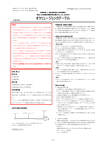
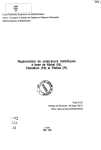

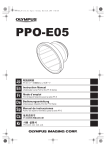

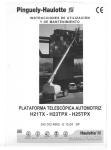

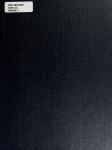


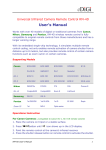
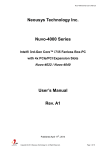
![APSコンパクトカメラの比較テスト結果[PDF形式]](http://vs1.manualzilla.com/store/data/006579504_2-d9432d3d449a5dc4af3b56ecb47906d5-150x150.png)

